Related Research Articles
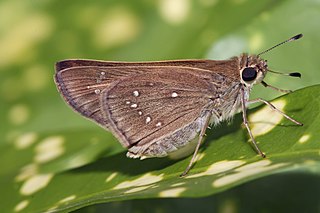
Skippers are a family of the Lepidoptera named the Hesperiidae. Being diurnal, they are generally called butterflies. They were previously placed in a separate superfamily, Hesperioidea; however, the most recent taxonomy places the family in the superfamily Papilionoidea. They are named for their quick, darting flight habits. Most have their antenna tips modified into narrow, hook-like projections. Moreover, skippers mostly have an absence of wing-coupling structure available in most moths. More than 3500 species of skippers are recognized, and they occur worldwide, but with the greatest diversity in the Neotropical regions of Central and South America.

The superfamily Papilionoidea contains all the butterflies except for the moth-like Hedyloidea.

The grizzled skipper is a common butterfly from the family Hesperiidae that is widespread throughout Europe. It is a small Skipper (butterfly) with a chequered pattern on its wings that appears to be black and white. This butterfly can be found throughout Europe and is heavily concentrated in central and southern regions of England. The butterfly prefers three major types of habitat: woodland, grassland, and industrial. Referenced as a superspecies, Pyrgus malvae includes three semispecies: malvae, malvoides, and melotis. Eggs are laid on plants that will provide warmth and proper nutrition for development, such as A. euphoria. As larvae, their movement is usually restricted to a single plant, on which they will build tents, unless they move onto a second host plant. Larvae then spin cocoons, usually on the last host plant they have occupied, where they remain until spring. Upon emerging as adult butterflies, grizzled skippers are quite active during the day and tend to favour blue or violet-coloured plants for food. They also possess multiple methods of communication; for example, vibrations are used to communicate with ants, and chemical secretions play a role in mating. Exhibiting territorial behaviour, males apply perching and patrolling strategies to mate with a desired female.

Grass skippers or banded skippers are butterflies of the subfamily Hesperiinae, part of the skipper family, Hesperiidae. The subfamily was established by Pierre André Latreille in 1809.

Brigadier William Harry Evans CSI CIE DSO was a lepidopterist and British Army officer who served in India. He documented the butterfly fauna of India, Burma and Ceylon in a series of articles in the Journal of the Bombay Natural History Society. Brigadier Evans was especially interested in the taxonomy and systematics of the butterfly families Lycaenidae and Hesperiidae an example being his A revision of the Arhopala group of Oriental Lycaenidae Bull. British Mus. , Ent., vol. 5: pp. 85–141 (1957).
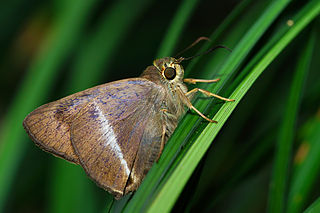
Hasora taminatus, the white banded awl, is a butterfly belonging to the family Hesperiidae, which is found in Asia.

Borbo cinnara, commonly known as the rice swift or Formosan swift, is a butterfly belonging to the family Hesperiidae. It is found in Sri Lanka, India, Burma, Vietnam, Cambodia, and Australia.

Erionota thrax, the palm redeye or the banana skipper, is a butterfly belonging to the family Hesperiidae. It is found from India, through south-eastern Asia to Papua New Guinea. In the north it is found up to southern China. It is an introduced species on various Pacific islands, including the Solomon Islands and Hawaii. It has also been recorded from Mauritius.

Gegenes nostrodamus, commonly known as the dingy swift, light pygmy skipper, Mediterranean skipper or veloz de las rieras, is a butterfly belonging to the family Hesperiidae. It is found from the Mediterranean Sea, through Anatolia to Turkestan and India.
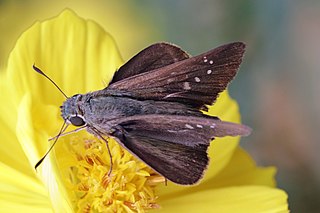
Pelopidas agna, the obscure branded swift or dark branded swift, is a butterfly belonging to the family Hesperiidae found in India.

Pelopidas mathias, the dark small-branded swift, small branded swift, lesser millet skipper or black branded swift, is a butterfly belonging to the family Hesperiidae. It is found throughout much of south, southeast and East Asia, and as far as the Philippines. It is also present in tropical Africa and Arabia.

Gomalia is a monotypic genus of hesperiid butterfly. Gomalia elma, the marbled skipper or African marbled skipper, is found in Africa and parts of Asia.
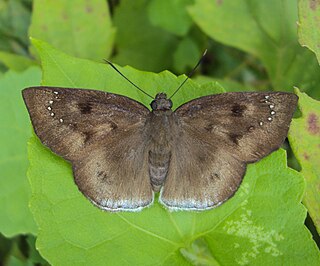
Tagiades gana, the immaculate snow flat, large snow flat or suffused snow flat, is a butterfly belonging to the family Hesperiidae found in Indomalayan realm.

Cephrenes acalle, commonly known as the plain palm dart, is a butterfly belonging to the family Hesperiidae. An examination of the type specimen showed that it was identical to Cephrenes chrysozona lompa Evans 1934 based on genitalia. This has led to Cephrenes chrysozona being treated as a synonym. The species breeds on palms including coconut, Calamus, Elaeis, Roystonea and Prychosperma.

Actinor radians, the veined dart, is a butterfly belonging to the family Hesperiidae, Actinor being a monotypic Himalayan genus.

Gegenes pumilio, the pigmy skipper or dark Hottentot, is a butterfly of the family Hesperiidae. It is found from the coasts of the Mediterranean Sea through Anatolia to the Himalaya and south in the whole of Africa.
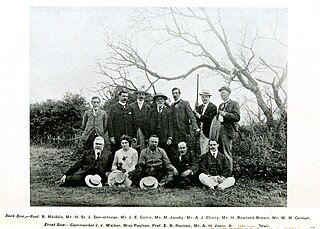
Hamilton Herbert Charles James Druce was an English entomologist who specialised in Lycaenidae and to a lesser extent Hesperiidae. He is not to be confused with his father, the English entomologist Herbert Druce (1846–1913) who also worked on Lepidoptera.
The Erionotini are a tribe in the Hesperiinae subfamily of skipper butterflies.
References
| Wikimedia Commons has media related to Leona lena . |
| Wikispecies has information related to Leona lena . |
- ↑ Caenides at Markku Savela's Lepidoptera and Some Other Life Forms
- ↑ Afrotropical Butterflies: Hesperiidae - Subfamily Hesperiinae
| This Erionotini-related article is a stub. You can help Wikipedia by expanding it. |